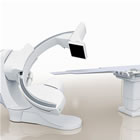
|
The five systems installed include two VF-i bi-plane systems, two CF-i single plane systems and one VF-i single plane system. Toshiba will provide information about the Infinix VF-i single plane at this year’s American College of Cardiology (ACC) annual meeting in New Orleans, April 2 - 5, 2011 (Booth # 2847). Most U.S. healthcare providers rely on femoral access for interventional procedures, despite its inherent risk of complications. However, research has shown that transradial intervention significantly reduces bleeding complications during angioplasty and stenting. In addition to being safer for the patient, it is also more comfortable. After radial intervention, patients experience rapid ambulation. The lower risk of complication coupled with faster ambulation results in speedier recovery, better patient comfort and reduced length of stay. By reducing the complications and improving recovery time, patients are discharged from the hospital faster, which help to lower overall healthcare costs. Relying on the Infinix-i vascular labs, the interventional team at Memorial Hermann Heart and Vascular Institute – TMC transitioned into performing more radial interventional procedures. The design of Toshiba’s Infinix-i systems with the flexible five-axis C-arm movement facilitates the radial approach with ease, as it allows clinicians to access the patient from either side, move the C-arm seamlessly, and situate the monitors and control panel to meet the needs of the interventional team. Dr. Barker is now using the radial approach in 80 percent of the interventional cases he handles, including both low-risk and high-risk cases such as diagnostics, type A lesions with a single blockage, ST-Segment Elevation Myocardial Infarction (STEMI), PCI, chronic occlusion and stenting in patients with weak hearts. “Toshiba’s Infinix-i vascular lab is ideal for radial interventions as it allows equal access to the right and left radial arteries,” explained Dr. Barker. “The design of the system enables us to move the monitors and change the positioning of the C-arm without having to pivot the table to reposition the patient, so we can operate from either side. This creates an ergonomically comfortable environment for the interventional team and the patient.” The Infinix VF-i single plane features a versatile multi-axis, floor-mounted C-arm providing unprecedented access to the patient, and over five feet of lateral travel at the head-end of the table for fingertip-to-fingertip coverage. In addition, the system’s tableside control cart and footswitch position provide a comfortable location for interventionalists to access the table panning handle. Monitors can be positioned on either side in front of the team, or moved closer for easy viewing. This unprecedented access and coverage of the floor-mounted five-axis, combined with the flexible positioning of tableside controls and monitor display, make this system ideal for performing transradial procedures with improved overall efficiency. Toshiba’s Infinix-i design incorporates numerous features to lower radiation and provide clinicians with the ability to attain the optimum blend of image quality and dose management. Quick exam times, system mechanics, shielding and system technology all contribute to limiting radiation dose to the lowest possible amounts for the desired clinical application. “The installation of five Infinix-i systems at Memorial Hermann is an example of Toshiba’s commitment to helping elevate patient care through improved workflow and reduced complications during interventional procedures,” said Doug Ryan, vice president, Marketing and Strategic Development, Toshiba. “With an unparalleled range of motion, the system helps increase collaboration between cardiologists and clinical staff, making it an ideal system to support radial intervention without compromising patient outcomes.” About Memorial Hermann Healthcare System About UTHealth About Toshiba Source: Toshiba America Medical Systems |
